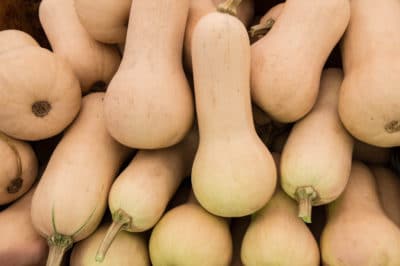What Does a Ripe Butternut Squash Look Like?
Before you can know when to pick your butternut squash, you first need to know what they look like when ripe. A fully mature butternut squash is wider at the bottom than the top, roughly shaped like a pear.
Additionally, the rind is a deep tan or beige, with an orangish tinge. If you notice even a slight hint of green or yellow, the squash is not ripe, and you should leave it on the vine. Last, the skin should have no shine to it but instead be a dull matte.
When Should I Start Harvesting?
Most winter squash are harvest at the end of October into mid-November. The same holds true for butternut squash. There are some signs you should look for to estimate how soon you can pick the squash.
- The vines will appear brown and withered regardless of how much water you give them.
- The stems of the squashes will begin to dry out and turn a silvery gray.
- The rind will be a uniform tan color.
- The skin will be hard enough to resist dents or scratches.
Tip: You can also keep track of the days from planting and as soon as 110 days have passed, check the plants for ripe squash.
How Long Can I Leave the Squash on the Vine?
Butternut squash will not continue to ripen once it is free from the vine, so you should allow it to stay on the vine as long as possible. However, butternut is sensitive to cold, so if there is a frost in the forecast, you need to cover the plants.
If you plan on storing your butternut squash harvest, it is even more critical to keep the squash on the vine until it reaches maturity. Doing so helps the rind to become hard enough to store the squash to supplement your winter diet.
However, although the squash will not continue to ripen after being freed from the vine, it will continue to cure in the sunshine. If you notice that some of the butternut squash rinds are not quite hard, leave them in the sun for a few additional days.
How Do I Pick Butternut Squash?
Although some of the butternut squash will fall off the vine on their own, you will need to cut most of them free when they are ripe enough to harvest.
Arm yourself with a pair of gloves to protect your hands from the bristly vines. Then, holding the vine carefully, cut through the stem with a sharp knife. When you cut, be sure to leave 2-3 inches (5-8 cm) of the stem. The stem is important because it keeps bacteria from entering into the flesh of the fruit and causing decay.
Tip: If any of your butternut squash have fallen off the vine, be sure to carefully inspect each fruit for signs of mold. If they are still good, be sure to use them first and do not place them in storage. One rotten squash can quickly spoil the entire crop.
Store and Enjoy!
Once you have picked the harvest and tasted the flavor of home-grown butternut squash, you will likely never again buy them from a grocery store. Since you can store them for an extended period, you can enjoy the hearty flavor through most of the winter.
